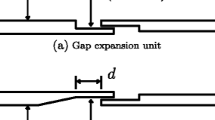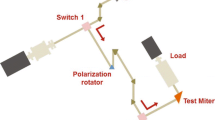Abstract
The Radio Frequency (RF) Cavities for the Continuous Electron Beam Accelerator Facility’s (CEBAF) superconducting linear accelerator have been design to operate at 2.0 K. A significant portion of the heat load to the 2 K system is supplied by the waveguides for the RF cavities. This heat load consists of three major components: a radiative component through the waveguide’s throat, a conductive component along the wall of the waveguide, and a heat generation component caused by the interaction of the RF wave with the waveguide’s wall.
A numerical model has been developed to evaluate the waveguide heat load. Utilizing this model, the influence of the conductive, radiative and generation com-ponents of the heat load have been evaluated and minimized.
The Southeastern Universities Research Association (SURA) operates the Continuous Electron Beam Accelerator Facility for the United States Department of Energy under contract DE-AC05-84ER40150.
Access this chapter
Tax calculation will be finalised at checkout
Purchases are for personal use only
Preview
Unable to display preview. Download preview PDF.
Similar content being viewed by others
References
P. Brindza, G. Biallas, L. Phillips, “An Optimized Input Waveguide for the CEBAF Superconducting Linac Cavity,” IEEE Trans, on Mag., 23:319 (1987).
Brookhaven National Laboratory, “Selected Cryogenic Data Notebook,” Vol. I, Associated Universities, Inc., Upton (1980).
Kearns, “Stainless Steel Thermal Properties,” CryoVac, Inc., Columbus (1964).
P. Lorrain and D. Corson, “Electromagnetic Fields and Waves,” 2nd ed., W.H. Freeman and Co., San Francisco (1970) p. 568.
F. Biquard and A. Septier, “Amelioration De La Conductivite Superficielle Du Cuivre Et De L’Aluminium En Hyperfrequences, Par Abaissement De Temperature”, Nuc. Inst. Meth., 44:18 (1966).
J.P. Holman, “Heat Transfer”, 5th ed., McGraw-Hill Book Co., New York (1981) p. 368.
R. Siegel and J.R. Howell, “Thermal Radiation Heat Transfer”, 2nd ed., McGraw-Hill Book Co., New York (1981) p. 824.
R. Barron, “Cryogenic Systems,” McGraw-Hill Book Co., New York (1966) p. 38.
T.R. Strobridge, “Refrigeration” in: “Technology of Liquid Helium,” R.H. Kropschot, B.W. Birmingham and D.B. Mann, ed., National Bureau of Stan¬dards, Boulder (1968) p. 82.
W.J. Schneider, Private Conversation.
Author information
Authors and Affiliations
Editor information
Editors and Affiliations
Rights and permissions
Copyright information
© 1990 Springer Science+Business Media New York
About this chapter
Cite this chapter
Kelley, J.P., Takacs, J. (1990). Thermal Design and Evaluation of the CEBAF Superconducting RF Cavity’s Prototype Waveguide. In: Fast, R.W. (eds) Advances in Cryogenic Engineering. Advances in Cryogenic Engineering, vol 35. Springer, Boston, MA. https://doi.org/10.1007/978-1-4613-0639-9_80
Download citation
DOI: https://doi.org/10.1007/978-1-4613-0639-9_80
Publisher Name: Springer, Boston, MA
Print ISBN: 978-1-4612-7904-4
Online ISBN: 978-1-4613-0639-9
eBook Packages: Springer Book Archive




